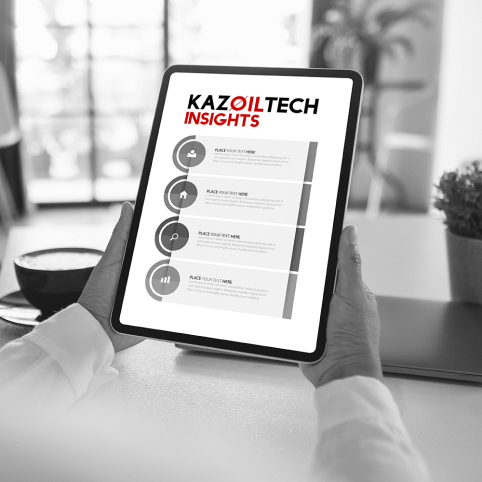The discussion around digital transformation has traditionally revolved around its power to drive innovation and create competitive advantage. Yet, there’s another angle that often gets overlooked: cost savings. The Oil & Gas (O&G) sector, in particular, stands to gain tremendously by adopting the right digital solutions. At Kazakhstan Oil & Gas Technology Center (KazOil Technology Center – KOTC), we believe in a different approach to digital transformation, one that optimizes costs while maintaining top-tier efficiency.
Too Long / Did’nt Read (TL;DR)
Achieving a cost-effective digital transformation in the Oil & Gas sector is possible through a tailored approach that addresses industry-specific challenges. Strategies like phased, modular implementation can spread out initial investment costs and reduce operational disruptions. Utilising cloud-based solutions eliminates the need for expensive physical infrastructure, while automating workflows lowers operational expenses. Integrated cybersecurity measures can remove the need for additional third-party solutions, and opting for custom-designed software ensures you only pay for the features you actually need. Overall, these strategies can reduce digital transformation costs by up to 30% or more, depending on specific circumstances.
Table of Contents
- Too Long / Did’nt Read (TL;DR)
- The Cost Reality of Digital Transformation
- IT Outsourcing Done Right!
- Rethinking Digital Transformation for O&G
- Domain Understanding: Bridging the IT-Industry Gap
- Siloed Organisational Structure: The Enemy of Efficiency
- Complex Software and Technology: A Daunting Task
- Driving Adoption: Resistance to Change
- Strategic Planning: The Missing Piece of the Puzzle
- Skill Gap: The Achilles’ Heel
- Security Concerns: The Looming Threat
- Budget Constraints: The Ever-Present Limitation
- Opportunities to Optimise Costs: Your Pathway to Affordable Digital Transformation
- The KOTC Advantage: A Bespoke Approach
- Conclusion

The Cost Reality of Digital Transformation
The buzz around digital transformation is palpable, but the expenditure involved can be equally staggering. In 2021 alone, global spending in this arena hit an astronomical $1.5 trillion. To put this into perspective, this growth isn’t just incremental; it’s exponential. With a compound annual growth rate of 9.1%, spending on digital transformation initiatives is projected to reach a jaw-dropping $6.8 trillion by the end of 2023.
But what do these colossal numbers mean for businesses, particularly in the Oil & Gas sector? The economic scale of digital transformation can make it appear as a daunting, if not prohibitive, venture for many. According to Altimeter Research, a significant 28% of organisations hold back from diving into this transformative journey, citing the initial investment as a significant roadblock.
Breaking Down the Cost Components
Understanding the hesitance requires delving into the cost structure of digital transformation. Broadly, these costs can be categorised into:
- Technology Expenses: This involves the cost of acquiring new software, hardware, and other technological infrastructure necessary for the transformation. In an industry like O&G, where specialised solutions are often the norm, these costs can be considerably high.
- Consultancy and Expertise: The need for industry-specific knowledge and technical expertise often means bringing in external consultants. Their fees can quickly add up, adding another layer to the overall cost.
- Training and Development: Implementing new systems requires re-skilling or up-skilling the existing workforce, which is an additional expense.
- Operational Disruption: During the transitional phase, a certain level of operational disruption is inevitable, which can indirectly contribute to the costs through decreased productivity and potential downtime.
- Maintenance and Upgrades: Even post-implementation, systems require ongoing maintenance, security updates, and potentially, future upgrades—all of which are recurring costs.
- Security Measures: With digital platforms come security risks. Mitigating these requires significant investment in cybersecurity measures.
The Hidden Costs
There are also ‘hidden’ costs, which are often underestimated or overlooked. These can include:
- Project Overruns: A delay in timelines can result in costs spiralling out of control.
- Data Migration Costs: Shifting from legacy systems to modern platforms often entails migration costs that are not always factored into initial estimates.
- Redundancy Costs: The move to more efficient systems can result in redundancy of hardware or even personnel, leading to severance costs.
The Opportunity Cost of Inaction
While the initial outlay for digital transformation can be intimidating, there’s also an opportunity cost of maintaining the status quo. In an industry as competitive and operationally intensive as O&G, falling behind on technology adoption can result in lost opportunities and reduced competitiveness over time.
It’s not just about the immediate financial burden; it’s about balancing that against the potential long-term gains. By not engaging in digital transformation, organisations risk becoming outdated, less efficient, and less competitive.
For those in the Oil & Gas sector, comprehending the full scope of costs is vital, not just for budgeting but also for strategising how to maximise ROI from digital transformation initiatives. This understanding serves as the foundation for a more affordable, yet equally effective, digital transformation journey, something that we at KOTC are committed to providing.


IT Outsourcing Done Right!
Outsourcing is no longer about just saving money, it is a strategic tool for accessing highly qualified experts to compliment your team and accelerate project delivery. The KazOil Technology Center team has an excellent track record for delivering high quality projects on time and on budget. Reach out to us for a free consultation with one of our experts.

Rethinking Digital Transformation for O&G
The hesitancy in the Oil & Gas (O&G) sector to embrace digital transformation isn’t baseless; it arises from a complex blend of unique challenges. These challenges can act as formidable barriers, discouraging organisations from undertaking the digital voyage. Let’s take an in-depth look at each of these obstacles and why they make the transition so difficult in this sector.
Domain Understanding: Bridging the IT-Industry Gap
One of the most significant hurdles in implementing digital transformation in O&G is the lack of IT professionals who genuinely understand the intricacies of the industry. This sector is not merely about extraction and supply; it’s a complex field that encompasses geology, engineering, regulatory compliance, and more. A generic IT solution often falls short of meeting these specialised needs, leading to inefficiencies and increased costs in the long run.
Siloed Organisational Structure: The Enemy of Efficiency
The highly siloed nature of many O&G companies exacerbates the complexity of implementing a cohesive digital strategy. Units often operate independently with little collaboration, making it difficult to integrate new digital systems smoothly across departments. The result? A patchwork of incompatible solutions that create more problems than they solve.
Complex Software and Technology: A Daunting Task
The O&G sector has unique requirements that off-the-shelf software solutions seldom meet. Be it reservoir simulations or predictive maintenance for machinery, the need for specialised software adds another layer of complexity and cost to digital transformation.
Driving Adoption: Resistance to Change
People are creatures of habit, and the O&G industry is no different. The workforce may be resistant to adopting new technologies and processes, often due to fear of the unknown or a perceived increase in workload. This resistance can significantly slow down the implementation process and, in some cases, lead to outright failure.
Strategic Planning: The Missing Piece of the Puzzle
Often, O&G organisations jump into digital transformation without a well-defined strategy, hoping that new technologies will solve their problems. This lack of strategic planning can result in suboptimal choices and wasted resources, negating any potential benefits.
Skill Gap: The Achilles’ Heel
An organisation can have the most advanced technologies at its disposal, but without the necessary skills to operate them, it’s a futile investment. The lack of IT skills within the existing O&G workforce can hinder the effective implementation and maintenance of new digital systems.
Security Concerns: The Looming Threat
As O&G operations become more digitised, they become attractive targets for cyberattacks. Concerns over data leaks, espionage, and sabotage are legitimate and add another layer of apprehension to the digital transformation equation.
Budget Constraints: The Ever-Present Limitation
Even if an O&G organisation is willing to confront all of the above challenges, there’s often the fundamental issue of budget constraints. The sizable initial investment required for digital transformation can be a significant deterrent, particularly for smaller players in the industry.
Opportunities to Optimise Costs: Your Pathway to Affordable Digital Transformation
When embarking on the journey of digital transformation, cost is often a major concern for decision-makers in the O&G sector. However, there are several strategic approaches that can significantly reduce financial burdens without compromising on the benefits. Here’s how KOTC leverages these opportunities to optimise costs for your digital transformation initiative.
Phased Implementation: The Modular Path to Success
Traditionally, digital transformation has been seen as an overwhelming overhaul that requires a significant upfront investment. However, a phased, modular approach can spread out these costs and mitigate operational disruptions. With KOTC’s expertise, we help you prioritise key areas for immediate transformation, allowing for incremental changes. This way, you see quicker returns on your investments and can use those gains to fund subsequent phases.
Cloud-Based Solutions: The Sky’s the Limit
The cloud offers a flexible and cost-effective alternative to traditional on-premises systems. With cloud-based solutions, you eliminate the need for costly physical infrastructure, such as servers and data centres, which can be both expensive to set up and maintain. Additionally, the cloud allows for seamless scaling, meaning you only pay for the computing power and storage you actually use.
Automating Workflows: The Efficiency Multiplier
Manual, repetitive tasks are not just time-consuming; they are also prone to human error, which can be costly to rectify. Automating these workflows can dramatically reduce operational expenses and free up your staff for more strategic, value-added activities. KOTC can help identify key areas for automation, from data entry to equipment monitoring, ensuring you get the most bang for your buck.
Cybersecurity: Secure and Cost-Effective
Security is a critical concern in digital transformation, but it doesn’t have to be a costly one. KOTC integrates robust cybersecurity measures into all our digital solutions. By doing so, we negate the need for additional third-party security solutions, which can often lead to compatibility issues and inflated costs. Our approach ensures that your systems are secure from day one, without the extra expense.
Tailored Software Solutions: Why Pay for What You Don’t Need?
Off-the-shelf software often comes with a plethora of features that may not be relevant to your specific needs, yet you pay for them nonetheless. KOTC offers bespoke software solutions that are tailored to meet the unique demands of the O&G industry. By focusing on functionality that adds value to your operation, we eliminate unnecessary features—and their associated costs.

The KOTC Advantage: A Bespoke Approach
Navigating the complex terrain of digital transformation in the Oil & Gas (O&G) sector requires more than just technological solutions; it requires a partner who understands the unique challenges and constraints of the industry. That’s where KOTC steps in, offering a uniquely tailored approach designed to not just meet but exceed your digital transformation needs.
Unparalleled Domain Expertise
What sets us apart is our unparalleled understanding of the O&G domain. Our team consists of seasoned professionals and subject matter experts who have hands-on experience in the industry. We know that a one-size-fits-all solution rarely works in a field as nuanced and specialised as O&G. This expertise enables us to provide customised solutions that resonate with the specific challenges and objectives of your organisation.
De-Siloing for Greater Efficiency
Our in-depth industry knowledge allows us to break down the siloed barriers that often plague O&G organisations. We foster a culture of interdepartmental collaboration, streamlining operations and ensuring a more cohesive and efficient implementation of digital technologies across the board.
Tackling Complex Software Needs
We understand the technological complexity that the O&G sector demands. Whether it’s reservoir simulation, predictive maintenance, or real-time monitoring systems, our solutions are designed to meet the industry-specific requirements head-on.
Overcoming Resistance and Fostering Adoption
Change management is a critical part of any digital transformation initiative. Our tailored solutions come with a robust plan for encouraging the adoption of new systems. We train your workforce, providing them with the skills and understanding they need to make the most of the new technologies.
Strategic Alignment
Unlike companies that thrust digital solutions upon organisations without a coherent strategy, KOTC places a high priority on strategic alignment. We develop and implement a comprehensive digital transformation roadmap that aligns with your organisation’s goals and objectives, ensuring a more targeted and successful transition.
Addressing Security Concerns
In an era where cyber threats are ever-present, especially in sectors that are becoming more digitised, we offer robust cybersecurity measures that are integrated into our digital transformation solutions. This not only ensures the safety of your data but also provides peace of mind as you move forward with your digital journey.
Cost-Effective Implementation
Perhaps most importantly, our customised, industry-focused approach results in substantial cost savings. We bypass the need for external consultants and avoid the implementation of unnecessary or redundant technologies. Depending on the unique requirements and challenges of your project, we can reduce implementation costs by up to 30% or more.
By choosing KOTC as your digital transformation partner, you’re not just opting for a service provider; you’re gaining a partner committed to your organisation’s long-term success. We invite you to reach out for a no-obligation consultation, where we can discuss your specific needs and how we can offer expert guidance and ongoing support tailored to your organisation. The future of O&G is digital, and with KOTC, that future is not just attainable; it’s affordable.
Conclusion
There’s no question that digital transformation represents a critical pivot for the future of the O&G industry. However, this transition doesn’t have to break the bank. KOTC is your partner in achieving this critical shift affordably and efficiently.
Interested? Reach out to us for a no-obligation consultation. We are committed to understanding your unique needs and offering expert guidance and ongoing support.
Take the step toward a cost-efficient, robust digital future in the O&G sector with KOTC. Your bottom line will thank you.








